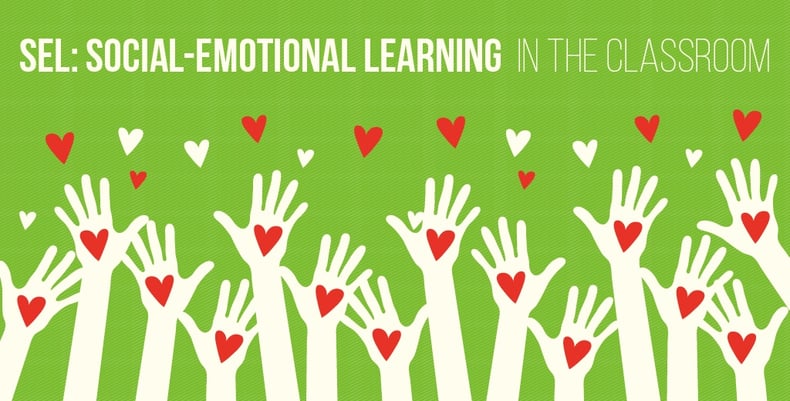
Social-emotional learning (SEL) is critical in today’s classroom. Students need to be taught how to handle their emotions in order to be contributing members of society. Students don’t always come to school equipped with these skills, which makes our job of teaching them even more important.
Five Critical Skills of SEL
There are five critical skills and competencies of social-emotional learning: self-awareness, self-management, social awareness, relationship skills, and responsible decision-making. The basic premise behind these core competencies is that teaching emotional well-being will lead to academic success. When children feel loved and safe, their brains are more ready and capable of learning to their full potential.
Here are six quick and easy ways to implement SEL in your classroom today:
- School Family
Have students bring in a family picture to share with the class—I usually do this at the beginning of the year, but you can start this at any time. Ask them questions and show interest about their family members and hang these pictures up on a bulletin board so they can see this home/school connection every day.
As you teach and build up your classroom environment, students will learn that they are all part of your “school family.” Show this by hanging pictures of students and classroom activities near the family pictures. You can change out these pictures throughout the year. I hang all these pictures up near our classroom rules as a reminder to my students that following the rules or norms of the classroom is how our school family works—and having their family pictures remain up throughout the year helps remind them of that important connection. Plus, it usually puts a smile on their faces as they see their loved ones looking back at them each day.
- Greet Students
Stand at the doorway (or place your work area near the door) and as students come in each day, be sure to greet them. Look them in the eye and tell them good morning by name. Have a special handshake with them. Notice when they lose a tooth, get new shoes, or get a haircut. You immediately let your students know you care and it starts everyone’s day off on the right foot.
After I greet my students personally, I see them smiling as they hang up their backpacks. It also lets me know who has had a rough morning at home—I can usually give those kids some extra TLC throughout the day, or even pull them aside to ask about any concerns they may have. Sometimes I may have those students stand by my side and help me greet others or go to get a drink (for some reason, taking a calming minute to get a drink of water seems to help my students regain focus). - Catch Them Being Good
Offer words of encouragement to all students at some point in the day (especially those challenging students—they often need it the most). Be specific when offering your words. Students don’t necessarily process the term “good job” so instead say “good job on writing your first name/calculating those math problems/etc.”
Also, when you see an act of kindness from one student to another, let them know. Sometimes I stop the whole class with a loud sigh (usually they think something bad just happened), grab my camera to take a picture, and add it to our bulletin board of pictures. This often initiates a series of kind acts. I continue to take pics or—if I don’t have my camera handy—I mimic the action with my fingers, which at least lets them know the kind act was noticed. - Compliment Board
Spotlight two or three students each day on a whiteboard and have the other students write compliments about those students. You don’t even necessarily have to take time out of your instruction to read them—they can read the comments for themselves!
For younger students, have them stand up in a circle and take turns putting two or three students in the center, giving the other students an opportunity to say something kind about them. This helps build positive relationships between students. - Problem Solvers
It is so important to teach students how to handle their emotions when dealing with problems. Teach students about taking deep breaths, using their words instead of their hands, and how to listen. I tell my students to first try to use their words when handling a problem, but if that doesn’t work, come talk to me (or a pre-approved student problem solver) to help work out the problem.
If a student comes to talk to you about a problem, listen and remember that they may not be fully equipped to deal with some problems on their own. It’s important not to brush them off as tattling—we have to stop and listen to what they are telling us. This helps them feel heard and understood. At first, this may seem time-consuming, but teaching them how to deal with their problems appropriately will lend itself to independence. - Closure
At the end of the day, take about 5–10 minutes for closure. Talk about the day—start by saying something positive, such as everyone worked really hard together on that science project or point out a kind act between students. If there was a problem during the day, just spend a minute or two talking about it and move on quickly, reassuring them that tomorrow will be a better day.
You can also let each student say something about the day (no pressure on those who don’t want to speak) or any other thought they may have on their mind. I do have to limit them to just one thought so I don’t run out of time. Then end the day with a song and a handshake, hug, or fist pump as they leave the classroom. You have ended the day on a positive note and sent them home with a smile and warm thoughts.
Daily Practice Makes Perfect
Taking the time each day to incorporate social-emotional learning into your classroom will benefit everyone. This will teach your students how to cultivate positive and healthy relationships, which will create harmony in your classroom—as well as improve your school’s culture and climate. Ultimately, these skills will help students prosper in life. Equipping our students with the knowledge and power to manage their emotions will empower them to graduate high school, continue their education, and pursue a career.
Stay up to date on SEL and other best practices and tips by subscribing to our Educator blog. Get the latest news, trends, and insights delivered right to your mailbox. Subscribe today!>>



